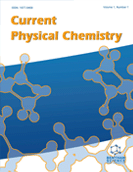Abstract
Aims: This study aimed at determining the synthesis, DFT studies, and specific heat capacity (Cp) of azo dyes composed of derivatives of 2-aminothiazole and thymol.
Background: To date, azo dyes have transitioned from the science of molecules to the science of materials very elegantly. 2-aminothiazole and thymol have a wide biological application window. Therefore, attempts have been made to couple these two biologically important organic frameworks via a diazotization strategy.
Objective: The objective of this study was to explore thymol as a coupling partner for the synthesis of azo dyes via a diazotization strategy. Furthermore, the structures of the synthesized azo dyes have been confirmed using DFT calculations. In addition, thermal profiles (TGA-DSC) have been explored elegantly to calculate specific heat capacity (Cp) as a function of temperature for the synthesized azo dyes.
Methods: A unit operation, i.e., diazotization, has been tuned very aptly for the formation of azodye framework based on 2-aminothymol and thymol. Thereafter, the thermal stability of the synthesized azo dyes has been addressed using TGA-DSC. Moreover, the Density Functional Theory has also been used to confirm vibrational frequencies of the synthesized azo dyes.
Results: In the present work, the effect of electronic parameters on the melting temperature of the corresponding azo dyes has been comprehended with the help of DSC analysis. Specific heat capacity data as a function of temperature for the synthesized dyes have been reported for the first time.
Conclusion: Melting behavior of the synthesized azo dyes is determined based on electronic effects with the help of thermal analysis. The specific heat capacity data can be helpful for the chemists, those engaged in chemical modelling, as well as for further docking studies. The structures of these synthesized azo dyes have been confirmed by performing DFT calculations, and to our delight, the comparison of both the experimental and calculated vibrational frequency data is found in good agreement with each other.
Keywords: Diazotization, TGA-DSC, specific heat capacity, DFT study, vibrational frequency, azo dyes.
Graphical Abstract
[http://dx.doi.org/10.1016/B978-0-12-811518-3.00022-3]
[http://dx.doi.org/10.1155/S1110662X05000140]
[http://dx.doi.org/10.1016/j.dyepig.2008.09.021]
[http://dx.doi.org/10.1016/j.enzmictec.2006.12.005]
[http://dx.doi.org/10.1016/j.ibiod.2006.08.006]
[http://dx.doi.org/10.1021/cr200213s] [PMID: 21981343]
[http://dx.doi.org/10.1021/bk-2015-1211.ch007]
[http://dx.doi.org/10.1021/bk-2015-1213.ch009]
[http://dx.doi.org/10.1016/S0143-7208(02)00053-0]
[http://dx.doi.org/10.1002/jhet.5570400607]
[http://dx.doi.org/10.1016/j.dyepig.2003.12.011]
[http://dx.doi.org/10.1016/j.dyepig.2008.03.008]
[http://dx.doi.org/10.1016/j.dyepig.2010.07.011]
[http://dx.doi.org/10.1007/s00044-012-0314-5]
[http://dx.doi.org/10.1016/j.jscs.2011.11.012]
[http://dx.doi.org/10.1039/C6OB00994H] [PMID: 27376825]
[http://dx.doi.org/10.1007/s10973-016-5784-0]
[http://dx.doi.org/10.2174/2213346105666181001111019]
[http://dx.doi.org/10.1103/PhysRevA.38.3098] [PMID: 9900728]
[http://dx.doi.org/10.1063/1.464913]
[http://dx.doi.org/10.1103/PhysRevB.37.785] [PMID: 9944570]
[http://dx.doi.org/10.2174/1573412916999200430092644]
[http://dx.doi.org/10.1002/slct.201904837]
[http://dx.doi.org/10.1615/CatalGreenChemEng.2020031663]
[http://dx.doi.org/10.2174/1877946810999200519102040]
[http://dx.doi.org/10.1039/C9OB01152H] [PMID: 31241119]
[http://dx.doi.org/10.2174/1877946808666181031113024]
[http://dx.doi.org/10.18520/cs/v114/i12/2525-2529]
[http://dx.doi.org/10.1007/s12034-018-1705-0]
[http://dx.doi.org/10.1134/S1070428020100243]

















